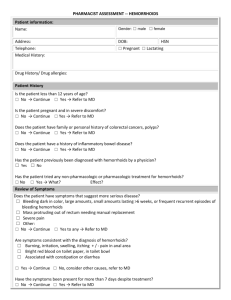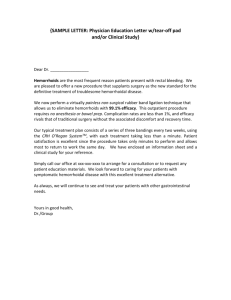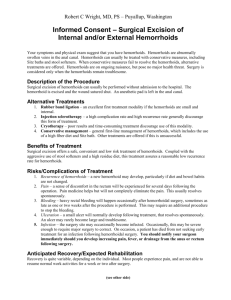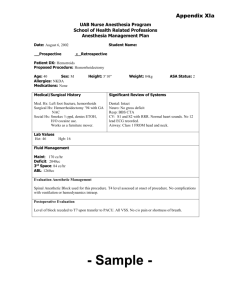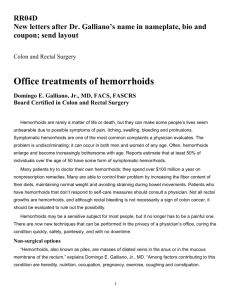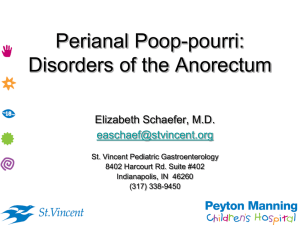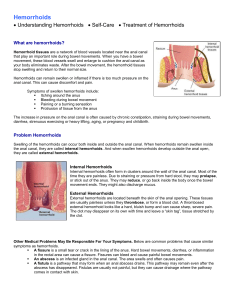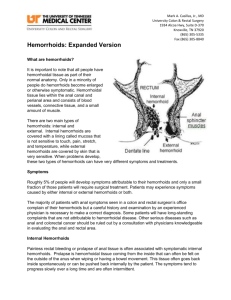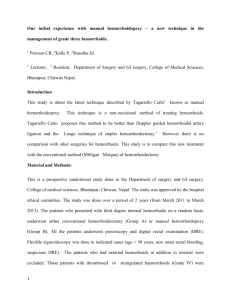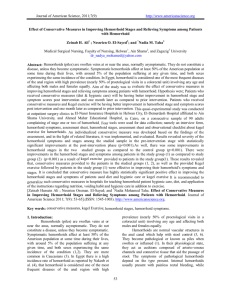Hemorrhoids
advertisement
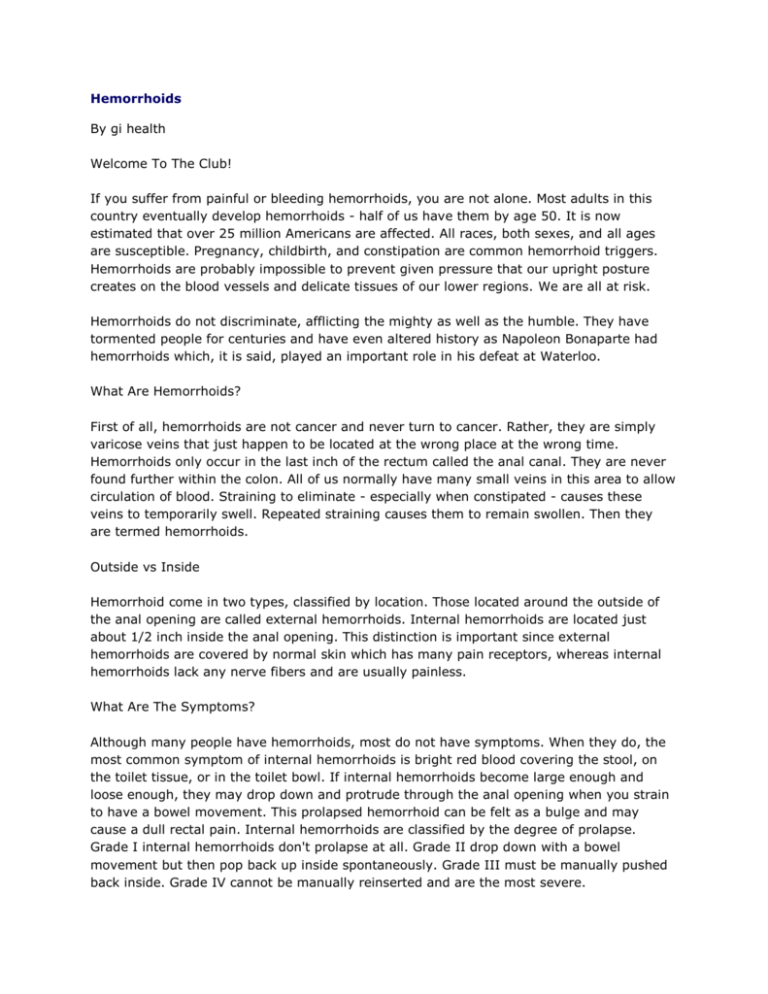
Hemorrhoids By gi health Welcome To The Club! If you suffer from painful or bleeding hemorrhoids, you are not alone. Most adults in this country eventually develop hemorrhoids - half of us have them by age 50. It is now estimated that over 25 million Americans are affected. All races, both sexes, and all ages are susceptible. Pregnancy, childbirth, and constipation are common hemorrhoid triggers. Hemorrhoids are probably impossible to prevent given pressure that our upright posture creates on the blood vessels and delicate tissues of our lower regions. We are all at risk. Hemorrhoids do not discriminate, afflicting the mighty as well as the humble. They have tormented people for centuries and have even altered history as Napoleon Bonaparte had hemorrhoids which, it is said, played an important role in his defeat at Waterloo. What Are Hemorrhoids? First of all, hemorrhoids are not cancer and never turn to cancer. Rather, they are simply varicose veins that just happen to be located at the wrong place at the wrong time. Hemorrhoids only occur in the last inch of the rectum called the anal canal. They are never found further within the colon. All of us normally have many small veins in this area to allow circulation of blood. Straining to eliminate - especially when constipated - causes these veins to temporarily swell. Repeated straining causes them to remain swollen. Then they are termed hemorrhoids. Outside vs Inside Hemorrhoid come in two types, classified by location. Those located around the outside of the anal opening are called external hemorrhoids. Internal hemorrhoids are located just about 1/2 inch inside the anal opening. This distinction is important since external hemorrhoids are covered by normal skin which has many pain receptors, whereas internal hemorrhoids lack any nerve fibers and are usually painless. What Are The Symptoms? Although many people have hemorrhoids, most do not have symptoms. When they do, the most common symptom of internal hemorrhoids is bright red blood covering the stool, on the toilet tissue, or in the toilet bowl. If internal hemorrhoids become large enough and loose enough, they may drop down and protrude through the anal opening when you strain to have a bowel movement. This prolapsed hemorrhoid can be felt as a bulge and may cause a dull rectal pain. Internal hemorrhoids are classified by the degree of prolapse. Grade I internal hemorrhoids don't prolapse at all. Grade II drop down with a bowel movement but then pop back up inside spontaneously. Grade III must be manually pushed back inside. Grade IV cannot be manually reinserted and are the most severe. External hemorrhoids are always outside by definition. They rarely bleed, but can cause embarrassing rectal itching and soreness. Rarely, a blood clot can form within an external hemorrhoid turning it blue. This thrombosed hemorrhoid causes sudden severe rectal pain and usually requires a trip to the Emergency Department or surgeon's office. Sitz baths, sitting in a few inches of warm water in a tub, several times a day may ease the pain of a clot enough that surgery is not needed. How Does Your Doctor Know? Diagnosis is an important first step in treatment. Any adult who has rectal symptoms especially bleeding - should call their doctor to schedule an evaluation. Hemorrhoids are seldom medically serious by themselves, but because they can bleed, they can sometimes lull people who have significant bowel disease into believing nothing much is wrong. Rectal bleeding must always be checked out by someone who can tell you the cause, and this caution applies even to those who have been diagnosed with hemorrhoids in the past because you never know when new bleeding is due to some new tumour. Rectal bleeding might mean early colon cancer, not hemorrhoids. Your doctor has several diagnostic tools at his disposal to accurately evaluate the source of rectal bleeding and determine what treatment is best advised. Such testing may include a digital rectal exam with a gloved finger and a "scope" test to visualize exactly what is wrong. A simple short scope test of the lower colon, called flexible fiberoptic sigmoidoscopy, is often sufficient. In some cases your doctor may suggest colonoscopy - a more complete examination of the entire colon. Simple Things First Hemorrhoids are not a sign of serious disease so the decision to treat depends on how bothersome they have become. In the vast majority of cases, surgery is not necessary. You may need to do nothing more than add extra fiber and fluids to your diet to prevent constipation, avoid straining, and avoid sitting for long periods of time on the toilet. You should immediately switch to a softer brand of toilet paper such as Charmin Plus. Many patients find cleansing the anal area afterwards with a baby wipe such as Chubs is soothing. Adding Fiber To Your Diet High fiber foods add bulk and softness to the stool to reduce constipation and straining. If you are troubled by hemorrhoid symptoms, you should gradually increase the insoluble fiber in your diet to about 30 grams a day and drink eight or more cups of fluid a day. (Coffee, tea, cola, or alcohol don't count) Insoluble fiber is easy to find. It is present in many fruits, vegetables, bran cereals, and wheat bran. You should add foods such as bran cereal, pears, raspberries, green beans, asparagus, broccoli, corn, kale, peas, Brussels sprouts, squash, yams, sauerkraut, zucchini, and cooked dried beans. Eat fruits raw and leave skins on. Use only whole wheat bread. Use A Fiber Supplement Daily With today's hectic lifestyles, it is not always possible to get enough fiber by diet alone. In addition to eating more fiber-containing foods, we suggest that you take a fiber supplement drink daily. The two most common are those made with psyllium seed, such as Metamucil, and those made with methlycellulose, such as Citrucel. A few teaspoons in a glass of water each morning is usually sufficient. Some patients also benefit from taking a stool softener such as docusate sodium, one brand of which is Colace. All of these substances are safe for long term use and not habit forming like other laxative products. Try Over-The-Counter-Remedies Many people seek over-the-counter remedies. Salves and suppositories may soothe hemorrhoids until the tissues around them can heal, but they don't make hemorroids disappear. Cortisone products can reduce inflammation. Witch Hazel, a natural astringent, bought separately, or as pre-moistened Tucks Pads, may reduce swelling. IRC: Infrared Coagulation Infrared Coagulation is a new nonsurgical technique that has revolutionized the treatment of symptomatic internal hemorrhoids. Much like a laser, this device focuses infrared light on hemorrhoid tissues, coagulating them. In the same way that blocking a stream will dry up a lake, IRC coagulates the "feeder veins" that deliver blood to the hemorrhoids. By gradually cutting off the blood supply, the hemorrhoid shrinks and symptoms subside. This technique is now offered in our office. Usually three to four treatments are required. But, this simple office procedure only takes about 5 minutes, is practically painless, and requires no incision or lengthy recovery or time lost from work. The success rate is high and surgery can be avoided in about 80% of patients. The Rubber Band Trick Another nonsurgical technique that has had good success is rubber band ligation. This is most popular for grade III and IV internal hemorrhoids. Using a special instrument, the surgeon snares the hemorrhoid and slips a tiny rubber band around it. With its blood supply cut off, the hemorrhoid slowly shrivels and disappears. Surgery: The Last Resort Surgical treatments should be reserved for patients with acute pain, persistent heavy bleeding or soiling that cannot be controlled in any other way. If all simple measures do not bring relief, your surgeon will decide which operation would be best for your particular case and will discuss the risks and benefits with you. Then you will be scheduled for hemorrhoidectomy - surgical excision of hemorroids. Nowdays, this surgery is usually done as an outpatient procedure. This means you have surgery in the morning, spend several hours in the recovery room, and then leave in the afternoon. The choice of anesthesia includes general, spinal or local anesthesia. General anesthesia means you are totally asleep on a breathing machine. Spinal anesthesia is done by injecting a novocaine-type drug into your spinal canal which temporarily makes your bottom and legs numb. The procedure can also be done under local anesthesia. Novacaine is injected into the rectal area to numb it and a little intravenous sedation is given so you drift asleep on your own. Regardless of the anesthesia, surgery takes about 20-60 minutes, depending on how much needs to be removed. After surgery, you will be taken to the post-anesthesia unit and then to the recovery room. After a few hours, you will be discharged and may return home. A few patients have difficulty urinating after hemorrhoid surgery and an overnight admission is required. These patients are usually discharged home the next morning. Bowel movements after this procedure are encouraged and assisted by using fiber supplements, laxatives, and stool softeners for a few weeks. As with any opeation, complications can sometimes occur, but the rate of serious complication is low. As any other operation most people experience pain, so your surgeon will prescribe pain medications. Most people will not find it necessary to take pain medication for more than 3-4 days. Sitz baths (sitting in a basin of warm water) four times a day works best in pain relief. You can go back to work when you are feeling better. That also depends on what type of work. Most people will not work for a 1-2 weeks. After excisional hemorrhoidectomy recurrences are uncommon. Not To Worry Hemorrhoids are annoying, uncomfortable, and often embarrassing, but never serious. Once your doctor has determined that your symptoms are only due to hemorrhoids, you need not worry. Just follow his advice concerning treatment.
